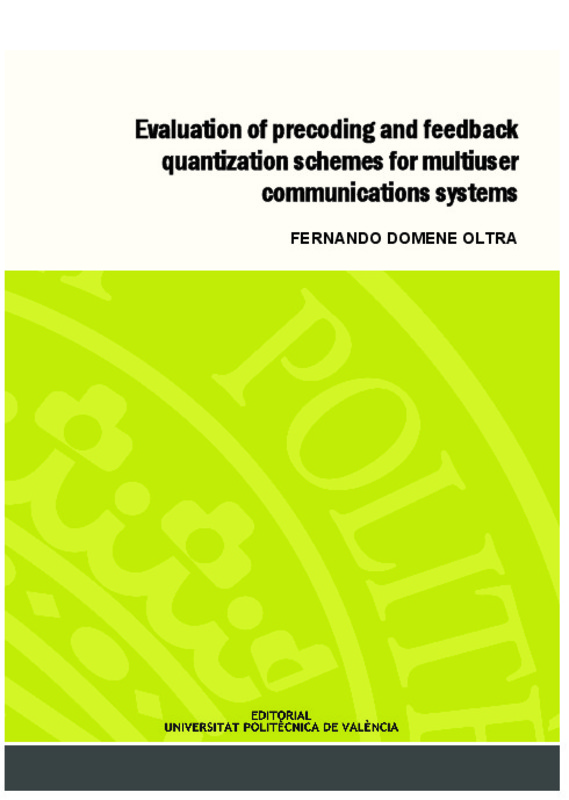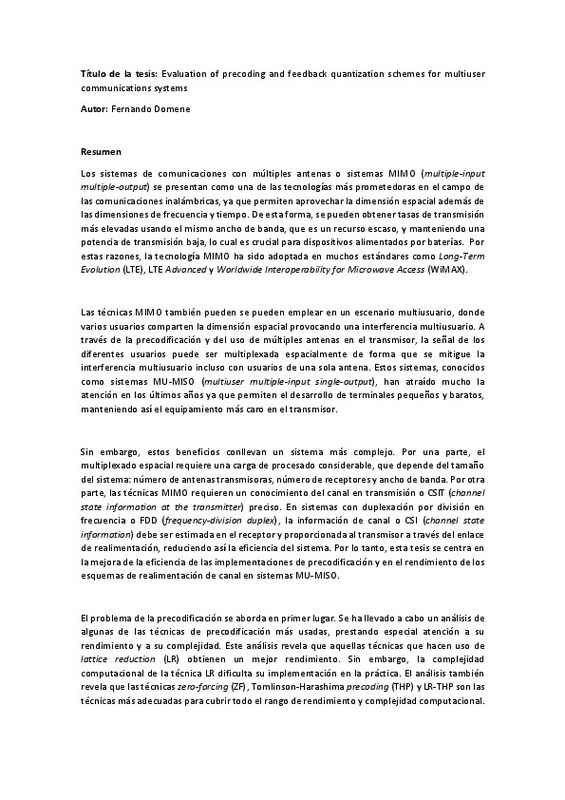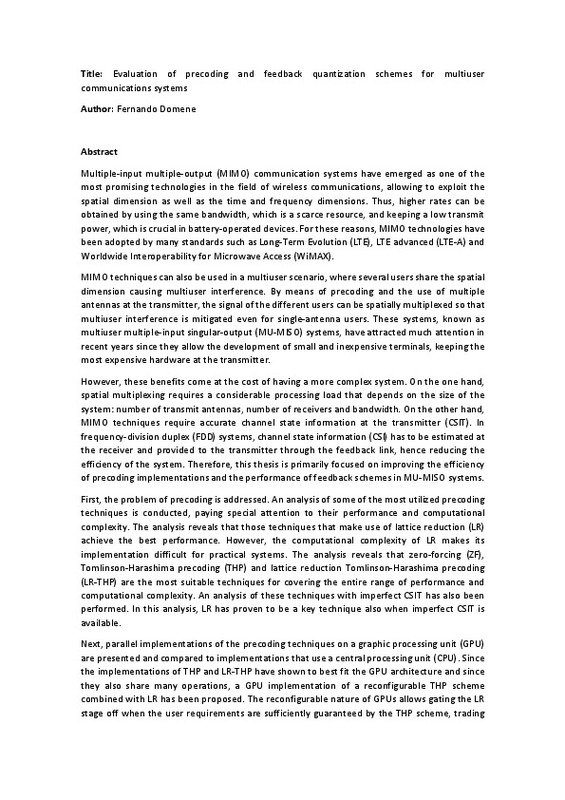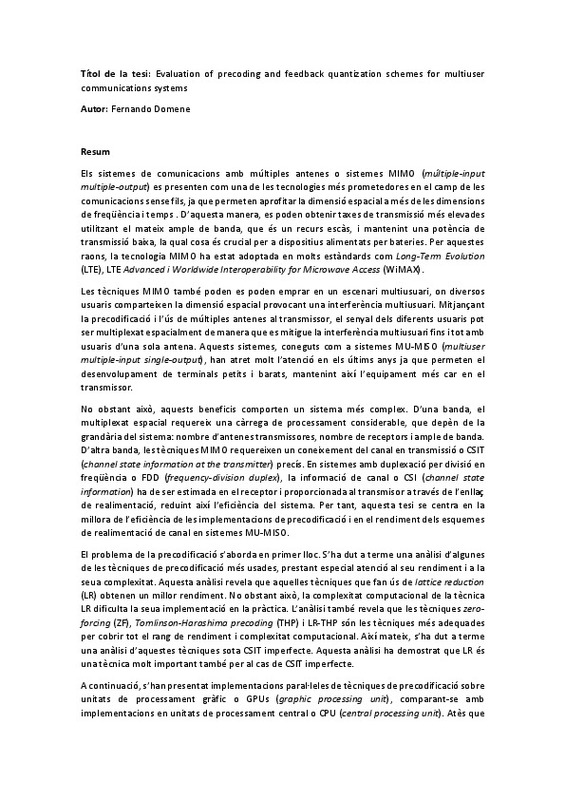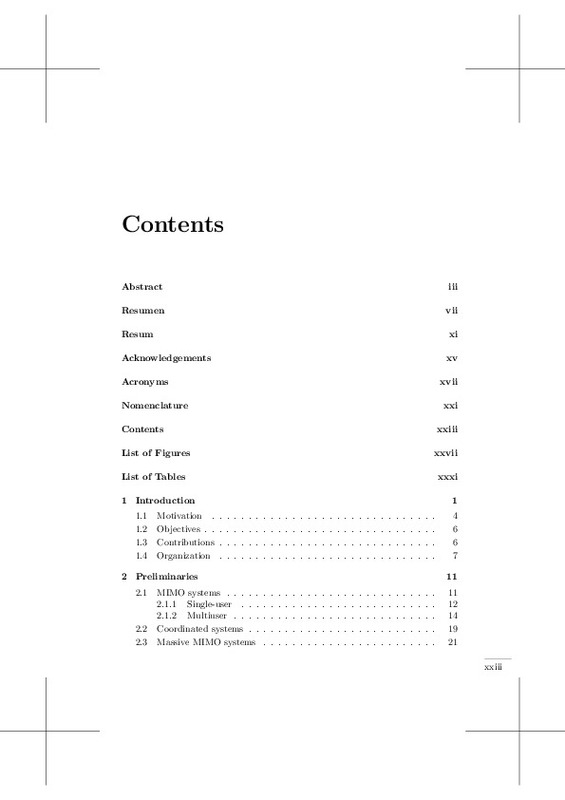- RiuNet repositorio UPV
- :
- Investigación
- :
- Tesis doctorales
- :
- Ver ítem
JavaScript is disabled for your browser. Some features of this site may not work without it.
Buscar en RiuNet
Listar
Mi cuenta
Estadísticas
Ayuda RiuNet
Admin. UPV
Evaluation of precoding and feedback quantization schemes for multiuser communications systems
Mostrar el registro sencillo del ítem
Ficheros en el ítem
| dc.contributor.advisor | Piñero Sipán, María Gemma
|
es_ES |
| dc.contributor.author | Domene Oltra, Fernando
|
es_ES |
| dc.date.accessioned | 2015-02-13T07:50:47Z | |
| dc.date.available | 2015-02-13T07:50:47Z | |
| dc.date.created | 2015-01-13T11:00:48Z | es_ES |
| dc.date.issued | 2015-02-13T07:50:43Z | es_ES |
| dc.identifier.isbn | 978-84-9048-329-9 | |
| dc.identifier.uri | http://hdl.handle.net/10251/46971 | |
| dc.description.abstract | Los sistemas de comunicaciones con múltiples antenas o sistemas MIMO (multiple-input multiple-output) se presentan como una de las tecnologías más prometedoras en el campo de las comunicaciones inalámbricas, ya que permiten aprovechar la dimensión espacial además de las dimensiones de frecuencia y tiempo. De esta forma, se pueden obtener tasas de transmisión más elevadas usando el mismo ancho de banda, que es un recurso escaso, y manteniendo una potencia de transmisión baja, lo cual es crucial para dispositivos alimentados por baterías. Por estas razones, la tecnología MIMO ha sido adoptada en muchos estándares como Long-Term Evolution (LTE), LTE Advanced y Worldwide Interoperability for Microwave Access (WiMAX). Las técnicas MIMO también pueden se pueden emplear en un escenario multiusuario, donde varios usuarios comparten la dimensión espacial provocando una interferencia multiusuario. A través de la precodificación y del uso de múltiples antenas en el transmisor, la señal de los diferentes usuarios puede ser multiplexada espacialmente de forma que se mitigue la interferencia multiusuario incluso con usuarios de una sola antena. Estos sistemas, conocidos como sistemas MU-MISO (multiuser multiple-input single-output), han atraído mucho la atención en los últimos años ya que permiten el desarrollo de terminales pequeños y baratos, manteniendo así el equipamiento más caro en el transmisor. Sin embargo, estos beneficios conllevan un sistema más complejo. Por una parte, el multiplexado espacial requiere una carga de procesado considerable, que depende del tamaño del sistema: número de antenas transmisoras, número de receptores y ancho de banda. Por otra parte, las técnicas MIMO requieren un conocimiento del canal en transmisión o CSIT (channel state information at the transmitter) preciso. En sistemas con duplexación por división en frecuencia o FDD (frequency-division duplex), la información de canal o CSI (channel state information) debe ser estimada en el receptor y proporcionada al transmisor a través del enlace de realimentación, reduciendo así la eficiencia del sistema. Por lo tanto, esta tesis se centra en la mejora de la eficiencia de las implementaciones de precodificación y en el rendimiento de los esquemas de realimentación de canal en sistemas MU-MISO. El problema de la precodificación se aborda en primer lugar. Se ha llevado a cabo un análisis de algunas de las técnicas de precodificación más usadas, prestando especial atención a su rendimiento y a su complejidad. Este análisis revela que aquellas técnicas que hacen uso de lattice reduction (LR) obtienen un mejor rendimiento. Sin embargo, la complejidad computacional de la técnica LR dificulta su implementación en la práctica. El análisis también revela que las técnicas zero-forcing (ZF), Tomlinson-Harashima precoding (THP) y LR-THP son las técnicas más adecuadas para cubrir todo el rango de rendimiento y complejidad computacional. Asimismo, se ha llevado a cabo un análisis de estas técnicas bajo CSIT imperfecto. Dicho análisis ha demostrado que LR es una técnica muy importante también para el caso de CSIT imperfecto. A continuación, se han presentado implementaciones paralelas de técnicas de precodificación sobre unidades de procesamiento gráfico o GPUs (graphic processing unit), comparándose con implementaciones en unidades de procesamiento central o CPU (central processing unit). Dado que las implementaciones de THP y LR-THP han demostrado ser las que mejor se adaptan a la arquitectura de la GPU y ya que tienen muchas operaciones comunes, se ha propuesto una implementación sobre GPU de un esquema THP reconfigurable combinado con LR. La reconfigurabilidad de las GPUs permite desactivar la etapa de LR cuando los requisitos de los usuarios están garantizados por el esquema THP, combinando complejidad computacional con rendimiento. Aunque esta implementación consigue una mejora significativa respecto a la implementación sobre CPU, su paralelismo viene limitado por la naturaleza secuencial del problema LR. Por ello, se han propuesto varias estrategias para la paralelización del problema LR que han sido evaluadas en distintas plataformas: CPU multi-núcleo, GPU y plataforma heterogénea que consiste en CPU+GPU. Los resultados revelan que la arquitectura GPU permite reducir considerablemente el tiempo de computación del problema LR, especialmente en la plataforma heterogénea. La segunda parte de la tesis trata el problema de la realimentación de canal en sistemas FDD. En estos sistemas, los receptores normalmente proporcionan una versión cuantificada del canal a través del canal de realimentación. Con el objetivo de mantener una eficiencia alta, el canal debe ser cuantificado con los mínimos bits posibles. En primer lugar, se explora el uso de la correlación en frecuencia para reducir el volumen de información de realimentación. Se han presentado dos esquemas diferentes basados en cuantificación vectorial o VQ (vector quantization) y en la transformación Karhunen-Loève, respectivamente, y se han comparado con esquemas existentes en términos de rendimiento y complejidad computacional. Los resultados muestran que ambas técnicas son capaces de reducir significativamente el volumen de información de realimentación aprovechando la correlación en frecuencia. Finalmente, la correlación espacial también se aprovecha para reducir la información de realimentación. Se ha presentado una caracterización espacial estadística del modelo de canal SCM (spatial channel model) del 3GPP (3rd Generation Partnership Project) para un entorno de alta correlación. Basado en esta caracterización, se propone un esquema de cuantificación de canal para entornos de alta correlación. Con el objetivo de obtener una caracterización para alta y baja correlación, se considera un modelo de correlación más sencillo como el modelo de Kronecker. Basado en esta caracterización, se proponen dos esquemas de cuantificación y se evalúan con un modelo de canal realista como el SCM. Los resultados muestran que ambos esquemas son capaces de reducir la información de realimentación en ambientes con correlación alta y moderada. | |
| dc.description.abstract | Multiple-input multiple-output (MIMO) communication systems have emerged as one of the most promising technologies in the field of wireless communications, allowing to exploit the spatial dimension as well as the time and frequency dimensions. Thus, higher rates can be obtained by using the same bandwidth, which is a scarce resource, and keeping a low transmit power, which is crucial in battery-operated devices. For these reasons, MIMO technologies have been adopted by many standards such as Long-Term Evolution (LTE), LTE advanced (LTE-A) and Worldwide Interoperability for Microwave Access (WiMAX). MIMO techniques can also be used in a multiuser scenario, where several usersshare the spatial dimension causing multiuser interference. By means of precoding and the use of multiple antennas at the transmitter, the signal of the different users can be spatially multiplexed so that multiuser interference is mitigated even for single-antenna users. These systems, known as multiuser multiple-input singular-output (MU-MISO) systems, have attracted much attention in recent years since they allow the development of small and inexpensive terminals, keeping the most expensive hardware at the transmitter. However, these benefits come at the cost of having a more complex system. On the one hand, spatial multiplexing requires a considerable processing load that depends on the size of the system: number of transmit antennas, number of receivers and bandwidth. On the other hand, MIMO techniques require accurate channel state information at the transmitter (CSIT). In frequency-division duplex (FDD) systems, channel state information (CSI) has to be estimated at the receiver and provided to the transmitter through the feedback link, hence reducing the efficiency of the system. Therefore, this thesis is primarily focused on improving the efficiency of precoding implementations and the performance of feedback schemes in MU-MISO systems. First, the problem of precoding is addressed. An analysis of some of the most utilized precoding techniques is conducted, paying special attention to their performance and computational complexity. The analysis reveals that those techniques that make use of lattice reduction (LR) achieve the best performance. However, the computational complexity of LR makes its implementation difficult for practical systems. The analysis reveals that zero-forcing (ZF), Tomlinson-Harashima precoding (THP) and lattice reduction Tomlinson-Harashima precoding (LR-THP) are the most suitable techniques for covering the entire range of performance and computational complexity. An analysis of these techniques with imperfect CSIT has also been performed. In this analysis, LR has proven to be a key technique also when imperfect CSIT is available. Next, parallel implementations of the precoding techniques on a graphic processing unit (GPU) are presented and compared to implementations that use a central processing unit (CPU). Since the implementations of THP and LR-THP have shown to best fit the GPU architecture and since they also share many operations, a GPU implementation of a reconfigurable THP scheme combined with LR has been proposed. The reconfigurable nature of GPUs allows gating the LR stage off when the user requirements are sufficiently guaranteed by the THP scheme, trading computational cost and performance. Although this implementation achieves a significant speed-up compared to its CPU implementation, its parallelism is limited by the sequential nature of LR. Therefore, several strategies for the parallelization of the LR problem are proposed and evaluated on different platforms: multicore CPU, GPU and a heterogeneous platform consisting of CPU+GPU. Results reveal that a GPU architecture allows a considerable reduction of the computational time of the LR problem, especially in the heterogeneous platform. The second part of this thesis addresses the problem of feedback in FDD systems. In these systems, a quantized version of the channel is usually provided by the receivers through the feedback link. In order to keep a high efficiency, the channel must be quantized using as few bits as possible. First, the use of the frequency correlation to reduce the feedback information is explored. Two different schemes based on vector quantization (VQ) and the Karhunen-Loève (KL) transform, respectively, are presented and compared with existing schemes in terms of performance and complexity. Results show that both techniques are able to significantly reduce the feedback overhead by taking advantage of the frequency correlation. Finally, the spatial correlation is leveraged to reduce the feedback information. A spatial statistical characterization of the spatial channel model (SCM) from the 3rd Generation Partnership Project (3GPP) for a highly correlated environment is presented. Based on this characterization, a channel quantization scheme for highly correlated environments is proposed. In order to obtain a statistical characterization for both high and low correlations, a simpler model such as the Kronecker correlation model is considered. Based on this characterization, two quantization schemes have been presented and evaluated using a realistic channel model such as the SCM. Results show that both schemes are able to reduce the feedback overhead in highly and moderately correlated scenarios. | en_EN |
| dc.language | Inglés | es_ES |
| dc.publisher | Editorial Universitat Politècnica de València | |
| dc.rights | Reserva de todos los derechos | es_ES |
| dc.source | Riunet | es_ES |
| dc.subject | Wireless communications | es_ES |
| dc.subject | Mobile communications | es_ES |
| dc.subject | MIMO | es_ES |
| dc.subject | Precoding | es_ES |
| dc.subject | GPU | es_ES |
| dc.subject | Limited feedback | es_ES |
| dc.subject | Channel quantization | es_ES |
| dc.subject | Signal processing | es_ES |
| dc.subject.classification | TEORIA DE LA SEÑAL Y COMUNICACIONES | es_ES |
| dc.title | Evaluation of precoding and feedback quantization schemes for multiuser communications systems | |
| dc.type | Tesis doctoral | es_ES |
| dc.identifier.doi | 10.4995/Thesis/10251/46971 | es_ES |
| dc.rights.accessRights | Abierto | es_ES |
| dc.contributor.affiliation | Universitat Politècnica de València. Departamento de Comunicaciones - Departament de Comunicacions | es_ES |
| dc.description.bibliographicCitation | Domene Oltra, F. (2015). Evaluation of precoding and feedback quantization schemes for multiuser communications systems [Tesis doctoral]. Editorial Universitat Politècnica de València. https://doi.org/10.4995/Thesis/10251/46971 | es_ES |
| dc.description.accrualMethod | TESIS | es_ES |
| dc.type.version | info:eu-repo/semantics/publishedVersion | es_ES |
| dc.relation.tesis | 8322 | es_ES |
Este ítem aparece en la(s) siguiente(s) colección(ones)
-
Tesis doctorales [5259]
-
Tesis. Editorial UPV [172]






